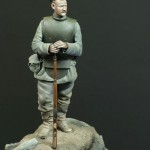
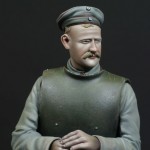

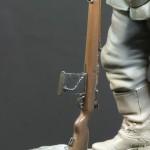
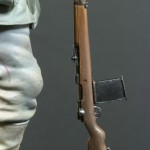
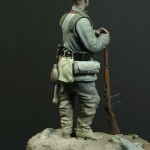
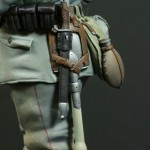
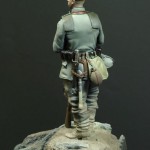
German Sentry, Infantryman, Western Front 1917
- Scale / Maßstab: 1:16
- Approx. height of figure: 114mm
- Material: Resin (figure), Model Plaster (base) / Resin (Fugur), Modell-Gips (Sockel – synethetische, kunststoffveredelte Gießmasse)
- Parts / Teile: 25
- Infosheet / Infoblatt: English
- Code: 25SP
Contents / Inhalt:
- Figure (8 parts) / Figur (8 Teile)
- Alternative Head (for Helmet) / 2. Kopf (für Stahlhelm)
- Ammunition Pouches M1909 / Patronentaschen M1909
- Water Bottle M1907 / Feldflasche M1907
- Haversack M1887 / Brotbeutel M1887
- Canvas Gas Mask Holder / Segeltuchtasche für Gasmaske
- Metal Cup M1916 / Tasse M1916
- Spade M1887 / Spaten M1887
- Bayonet M1898/1905 / Seitengewehr M1898/1905
- Mauser Rifle 98 / Gewehr 98
- Trench Magazine / Ansteckmagazin (Grabenmagazin)
- Steel Helmet M.16 / Stahlhelm M.16
- Large Figure Base / Gr. Figur-Sockel
Extracts from the Infosheet with this figure:
The figure depicts a German Infantryman on duty in the Front Line area during the winter 1917/18. He wears the armoured plate body armour associated with troops on guard duty, snipers or MG personnel within exposed areas of the Front.
The German Soldier of 1917 and 1918. The German soldier in 1917/18 had changed somewhat from his comrades of 1914. Firstly, he would have been much younger – on average about 18/19 years of age after finishing training – NCOs a year or two older. The style of his uniform differed not only in quality but functionality as well, with many items of clothing and equipment produced in Ersatz material, or a combination of mixed dress. Infantry Companies within the Front Line areas numbered on averaged 75 – 80 soldiers, some as low as 50 (a full Company strength would be around 135 men), with the bulk of its fighting capacity and experience held by only 15 – 20 old sweats. As the war progressed more emphasis was put onto automatic weapons and as many as 4 MG 08/15s per Infantry Company were issued.
Field Service Dress / Feldbluse M1915: This was to replace the early M1907/10 and the simplified M1914 service dress tunics. All three were in fact worn alongside each other throughout the war. The Bluse was a radical change in the design of combat clothing, with trials before the war and the new experience gained at the Front producing a garment without the unnecessary elements of the earlier tunics, giving the German soldier a completely different, in some cases baggy appearance. Designed for all arms of the service and for all ranks (Officers were allowed to acquire the Bluse in a better quality of material, but were not permitted to show difference in colour from the other ranks).
Colour: made out of a field grey material (the Light Infantry units, or Jäger and Schützen wore a green-grey version). All units had the turn down collar in resedagrün reed-green, exception being the Bavarians, who retained the field-grey material, piped on the outer edge (later only the front, vertical edges) in the State colours white / blue Rautenborte, a particular feature of Bavarian troops. The six front horn buttons to the Feldbluse were hidden behind a flap. The pocket and large rear buttons were cast in zinc and coated in nickel or Tombak (an alloy of copper and zinc, which had a matt bronze/yellow colour).
Steel Helmet M16 / Stahlhelm M.16: This helmet, which first entered service in 1916 during the initial stages of the battle of Verdun was designed by Professor Friedrich Schwerd and made from high quality chrome-nickel steel. Weighing between 950 and 1200g, depending on size – more heavier than the Allied helmets, but giving a better protection to the face, ears and neck. The horn venting bolts on each side enabled the fitting of an extra armoured shield over the helmet (also available in 1:16th scale from Jon Smith Modellbau) for sentries, MG troops, snipers or other particularly exposed / dangerous employment. This weighing around 2000g was seldom used; although a total of 50000 were supposedly produced.
Colour: first issued in field- grey, which would reflect in sun light and proved unsatisfactory. Various trials were carried out, but it was not until July 1918 that an official camouflage scheme in brown and green sharp-edged irregular patens, all outlined in black was introduced. These were carried out by unit maintenance workshops (other weapons and equipment, particularly artillery pieces and MGs were also rendered in the same way). It seems that helmets were re-painted by individuals or units in a variety of colour schemes before the official order and items with red- brown, ochre (brownish- yellow), green and blue- grey, all outlined in black were common. Helmets were also covered using the light brown sandbag material, or the issued helmet-covers, seen particularly in the later war period.
The M.17 & 18 helmets followed with only slight differences to the inside padding and chin strap fasteners. The last model to see service during the war, if only in small numbers was the M.18 Ohrenausschnitt, or Helmet M.18 with ear cut-outs (also available in 1:16th scale from JSM), more commonly (and stubbornly) known as the Cavalry or Telegraph Helmet. The cut-outs were in fact a further design feature of the M.18 to improve the hearing ability of the wearer and avoid the hissing noise experienced by troops.
Steel Body Armour / Grabenpanzer or Sappenpanzer: Devised by the German Army and introduced in 1916 for protection against light infantry weapons and shrapnel. This special nickel/silicon steel body armour, or trench armour was issued to predominantly exposed troops such as snipers, MG troops and sentries within the Front Line areas.
The armor consisted of a breastplate, with 3 overlapping protective sections for the stomach and groin. 2 shoulder plates fixed with 3 rivets on each side held the armour over the body. The individual plates were connected with 2 webbing straps fastened onto the inside of the armour starting on the breast section where the two rivets are situated. Rectangular horsehair felt pads were stitched to the webbing strap to lay in-between the sections and reduce noise when the wearer moved (the pads can be seen protruding under the plates on original photos and the model figure). The thickness of armour was approx. 3.25 mm with a 25mm overlap of the plates. Measurements would of cause differ from one set of armour to the next, there being at least 7 manufactures involved in production.
The armour was issued in different models, but basically 2 types can be discovered when searching for photos or original items. The first is the plain / first issue type (worn by this figure). The second model has 2 additional equipment support hooks on the main breast plate, along with a rifle bracket welded to the top area and attachment slits for securing a strap to go around the body and hold the armour in place. The weight, depending on the manufacture was between 8 and 10 Kg and appears to of been issued in either 2 or 3 different sizes.
Sources claim that between 400,000 and 500,000 were produced and is one of the most sought after items for any WW1 collector today. Considering how many were supposedly manufactured, there are not many around.
Colour: Judging by the few original items in museums and private collectors the factory colour is olive green. Horsehair pads: a light grey / brown.
Ammunition Pouches M1909 / Patronentaschen M1909: These ammunition pouches belonged to the standard equipment of the infantryman. Each comprised 3 smaller pouches mounted on a stiffened backing fastened with a strap held down by a small brass button (from January 1915 galvanized steel). Each pouch held 4 strips of 5 rounds, giving a total of 120 rounds per man.
Colour: Army regulation September 1915 stated that all leather equipment was to be issued blackened.
Canvas Gas Mask Holder / Segeltuchtasche für Gasmaske: In 1915 a canvas gas mask holder was issued with 2 dividing partitions within, which stowed the mask, filter and reserve-filter in a metal tin. The holder was generally worn either attached to the belt below the rucksack at the rear, or on the right side / front by means of 2 belt loops made from the same material and fastened with zinc buttons. Later versions of the holder had ring attachments on each of the belt loops enabling the fixing to the bread bag. Although generally used in the early part of the war, late war photos still show troops issued with this holder. The No. 2 at one end of the holder is the gas mask size and this has been modelled slightly raised to enable easier painting. On the model, part of the flap has lifted to reveal one side of the metal tin containing the spare filter. Colour: canvas holder – light grey- brown, number – dark coloured stamp colour – could have been black (on the original items these numbers are quite faded), filter tin – grey-green.
Metal Cup M1916 / Tasse M1916: The enamelled steel cup replaced the earlier aluminium version (production was discontinued in October 1914 due to lack of aluminium) and can be fixed to one of the bread bag fastening straps. The opposite end to the handle is a small indent in the rim to allow the cup to be used as a small jug. The official place for this cup was inside the bread bag. Colour: light olive green / field-grey.
Spade M1887 / Spaten M1887: Attached to the belt is the standard issued spade held in the leather holder. Colour: metal spade with brown leather holder and fastening straps.
Mauser Rifle 98 / Gewehr 98: The Gew. 98 derived from the less successful Gewehr 88 and became the standard German infantry rifle of the WW1. It had an overall length of 125 cm (49.25 inch) and fired the 7.92 mm round. It was a good rifle – well made, generally soldier proof and accurate at long ranges. Some of the first models were purchased by the Boers, who used them with great effect against the British in South Africa. Compared with the British Short Magazine Lee Enfield, the Gew. 98 had certain drawbacks. Even in experienced hands it could never keep up with the rate of fire of the British SMLE. A British infantryman could fire 15 aimed shots at 300 yards per minute and with some more experienced men managing 25-30 in the so called `mad minute´. Also, the length of the Gew. 98, especially when fixed with a bayonet was far too long in the confined spaces of the trenches. A further disadvantage was that the bolt handle stuck out at a 90°angle to the rifle, causing it to sometimes snag on uniform and equipment. On the right hand side of the butt there is the small metal disc where the unit identification was stamped. On the right hand side, at the end of the stock are the 2 metal locking splints used to dissemble the rifle. The cleaning rod seen under barrel was only approx. 30 cm long and had to be screwed together using 2 other rods from comrade’s rifles. Without the cleaning rod the rifle could not be stacked in 3s in the typical pyramid fashion of the day (particularly seen with German troops). Colour: wood – brown. Metal – dark metal.
On the plaster base an indent has been made for the positioning of the rifle butt (in front of the figure’s feet).
Trench Magazine / Ansteckmagazin für Gew. 98: (the designation Grabenmagazin or trench magazine was never used in the German Army, but has become the more common name now used for this item).
This 25 round `trench´ magazine or Mehrlader was developed to increase the rate of fire and was permanently fixed to the rifle (it was not possible to load the magazine when detached from the rifle). Manufacturing of the magazines began in October 1915 with the intention that every soldier at the Front should receive one. It was constructed from sheet steel and fed from the top of the weapon with clips of rounds. The small slide attached by a chain to the side of the magazine body would be placed into a slit at the top to avoid the magazine feed slide and spring from escaping whilst unattached (when not in use this would slip into the bracket at bottom as shown on this model).
There were not only advantages with the 25 round capacity – it suffered problems due to over-strength of the spring and was generally unwieldy in trench use. Additionally, the rifle could not be fired easily when resting on a trench parapet or in the prone (laying down) position. Colour: many of the original items show traces of dark grey or black paint.
When the rifle is position as on this figure, then the chain should hang down as shown. The fitting plug on the rifle can be removed and sanded down if wished, showing the G98 without the magazine.
The Base: The base supplied with the figure depicts a section of old trench within a wooded area, damaged by previous artillery fire. Part of a corrugated iron revetment from an old trench system can be seen to the rear side of base. Parts of the shattered tree stumps have slipped into the water filled crater.
Empty 7.92 mmCartridges / Leere 7.92mm Patronen: these can be placed on the ground as wished. Colour: brass.
 An deutschsprachige Interessenten:
Sie können mich per eMail oder Telefon auch gerne auf deutsch kontaktieren. Ortsbesuch ist nach Absprache möglich.
An deutschsprachige Interessenten:
Sie können mich per eMail oder Telefon auch gerne auf deutsch kontaktieren. Ortsbesuch ist nach Absprache möglich.
